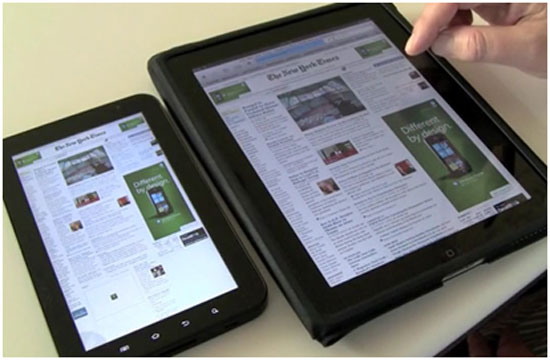Why Apple Should Make a 7-Inch IPad

Not that the iPad is flawed, but an iPad mini slate selling from $199 to $399 would replace the tiring iPod touch with a compelling, more portable entry in Apple's lineup.
Rumors of a smaller iPad made the rounds on Friday, as Asian supply channels indicate a 7.85-inch Apple tablet will arrive in late 2012. Apple (AAPL) essentially owns the consumer tablet market at this point, outselling all Android tablets combined by a sizable factor, depending on the sales numbers you look at. With such success for the iPad, why should Apple even bother with a smaller slate?
There are four reasons to consider such a device, even with the iPad as top tablet. Let me preface them with a baseline thought, however: I’m not suggesting the iPad isn’t a great tablet in its current form. It’s a breakthrough product that has created demand for a market that hasn’t had any since the first tablet PC was introduced in 2001. I have an iPad 2, which offers a superb experience, albeit in a limited fashion. That leads to the first of my reasons.
1. Smaller tablets are more portable. When you are sitting around the house or planning to be immobile at a Starbucks (SBUX), for example, the iPad fit the bill. But when moving around, the 7-inch Tab was the go-to device. It fits in a purse, a back pocket, or inside jacket pocket, while the iPad doesn’t. Smaller size equates to lighter weight, too: You can comfortably hold a small tablet far longer than a larger one.
2. Credible 7-inch tablets are appearing. In the year we’ve had the Tab, credible 7-inch alternatives have been selling well. Specifically, the Barnes & Noble (BKS) Nook Color from last year and the company’s more recent Nook Tablet and the Kindle Fire from Amazon (AMZN) are all hot holiday items. The portability factor is one reason, but the price point is more important: They are available for $199 to $249. As I said in my Kindle Fire review, you’re getting a device that does 80 percent of what an iPad can do—at 40 percent of the price.
3. The iPod touch now has limited appeal. One of the oft-quoted arguments against a smaller iPad is the existence of the iPod touch. iPod touch sales are likely to decline over time as more consumers buy smartphones and Apple adds carrier partnerships. And recently, Apple hasn’t invested much effort in advancing the iPod touch. This year’s “refresh” was the availability of a white model. To me, that’s a sign of iPod touch’s demise as a product line. This leads to the final point.
4. A smaller iPad hits iPod touch’s price. If Apple eventually shelves the iPod touch, it would lack a connected product in the $199-to-$399 price range. Enter the iPad mini slate, which at $199 competes head-on with the Kindle Fire at the same price. Like the iPod touch and the iPad, a smaller $199 iPad would likely be a Wi-Fi device with a contract-free option to add 3G support for an additional cost. For those who want the iPad experience but can’t afford its $499-to-$829 price range, a $199-to-$399 iPad mini opens accessibility. My guess is that Apple pricing would follow that of the iPod touch, with extra cost attributed to greater flash storage capacity.
September iPod event is in 2012. That’s right before the holiday season, a fitting time to launch the transition from iPod touch to iPad touch, or whatever Apple wants to name such a product.
